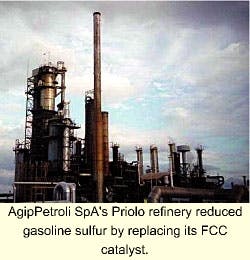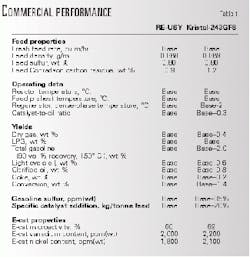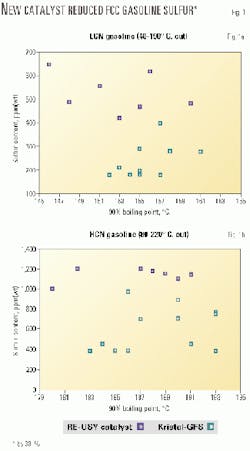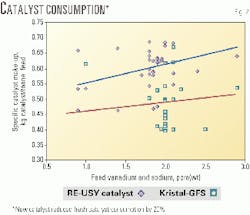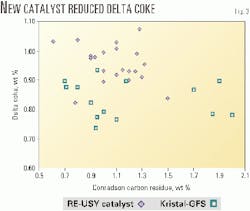New FCC catalyst reduces gasoline sulfur in Italian refinery
AgipPetroli SpA's refinery in Priolo, Italy, reduced the sulfur content in its full-range gasoline by 35% by using a new fluid catalytic cracking (FCC) catalyst technology.
At the same time, the unit increased its gasoline selectivity and reduced gas and coke yields.
Despite having to process atmospheric resid with high levels of contaminant metals, the Priolo refinery also reduced its fresh catalyst consumption by 20%.
Grace Davison's Kristal-243GFS catalyst technology is credited with these achievements. The catalyst enabled the Priolo refinery to deal economically with stringent environmental regulations on gasoline sulfur content and improve refinery profitability.
To meet the challenge of reducing gasoline sulfur, refiners are focusing on the FCC unit (FCCU). FCC naphtha typically makes up about one third of the gasoline pool and contributes more than 90% of the sulfur in the gasoline.
Each of the traditional strategies for reducing gasoline sulfur has strengths and weaknesses. Hydrotreating the FCC feed significantly reduces sulfur in both gasoline and diesel, but it requires a large capital investment. Hydrotreating the FCC naphtha accomplishes similar reductions in gasoline sulfur with lower hydrogen consumption and lower investment, but it often results in a significant loss in gasoline octane.
Since the sulfur is concentrated in the heavy end of the gasoline, undercutting the FCC gasoline is an option. This method leads to a significant loss of gasoline volume, however.
In late 1999, Grace Davison Europe commercialized a new catalyst technology for gasoline-sulfur reduction. GFS-2000 is a catalyst that contains a proprietary zeolite in an alumina-sol matrix.1 2 The design of GFS-2000 allows for formulation flexibility to optimize product yields.
Recent developments have allowed the introduction of the GFS function into several Grace Davison resid FCC catalyst series (into Kristal, Brilliant, and Futura).
AgipPetroli's Priolo refinery used Grace Davison's Kristal-GFS gasoline-sulfur reduction technology in its FCCU to meet the new limit of 150-ppm sulfur in the gasoline pool. Hydro treating facilities for FCC feedstock or FCC naphtha are not available in this refinery.
Sulfur reduction in FCC gasoline
The composition of sulfur species in FCCU feeds varies widely. A typical FCCU feed contains 0.6-2.5 wt % sulfur.
Gas chromatography and mass spectrometry (GC/MS) analyses reveal that sulfur species in the feed are composed of alkyl-substituted aromatic sulfur-containing rings and aliphatic and aromatic sulfides. The ring structures include thiophenes, benzothiophenes, dibenzothiophenes, and multi-ring sulfur species.
At typical levels of conversion, about 45% of the FCCU feed sulfur is converted to H2S by the FCC catalyst. About 5% is transferred into coke, which is later removed as SOx in the regenerator flue gas. About 45% remains in the light cycle oil (LCO) and bottoms, and only 5% is converted to gasoline-range sulfur species.
Analysis suggests that the dibenzothiophenes and multi-ring sulfur species tend to remain in the unconverted hydrocarbon fraction. A majority of the sulfides and disulfides in the feed are converted to H2S. Only a small fraction of the feed's sulfur compounds (alkylthiophenes and some sulfides) is converted to gasoline-range sulfur species.
One strategy to reduce sulfur in the gasoline is therefore to develop a catalyst that redirects the cracking of these specific sulfur species in the FCCU feed to reaction pathways that produce H2S.3 This pathway would directly reduce the formation of the gasoline-range sulfur species (see box, Reaction 1).
Another way to reduce gasoline sulfur is to develop a catalyst that acts on the gasoline sulfur species directly.3 FCC gasoline contains mercaptans, sulfides, alkyl-substituted thiophenes, thiophenols, and benzothiophene.
Benzothiophene, which often accounts for more than 30% of the sulfur in gasoline,4 is very difficult to remove. Thiophene is the sulfur analogue of benzene but is not nearly as thermodynamically stable.
Studies with model compounds carried out by Grace Davison suggest that thiophenes and alkylthiophenes can be converted to tetrahydrothiophenes by appropriate hydrogen-donating species.5 FCC catalysts with high hydrogen-transfer activity are known to reduce FCC gasoline sulfur.6 It is thought that high hydrogen-transfer catalysts promote the saturation of thiophene rings. The tetrahydrothiophenes formed are then much easier to crack, the sulfur being released as H2S (see box, Reaction 2).
A third possible mechanism to reduce gasoline sulfur would be to develop a catalyst that selectively transfers gasoline sulfur species into coke.3 This strategy would also have the undesirable effect of increasing coke production and SOx emissions, however (see box, Reaction 3).
Catalyst performance
Since the Priolo FCC unit processes significant amounts of atmospheric resid, the GFS functionality had to be built into one of Grace Davison's resid cracking catalysts.
The high levels of contaminant metals in the feedstock and the need to minimize dry gas yield made the Kristal catalyst series the best choice.
After careful consideration of the unit constraints and required product yields, AgipPetroli selected the Kristal-243GFS catalyst.
Catalysts from the Kristal series are the most widely used in resid operations in Europe and the Middle East.4-6
AgipPetroli replaced Grace Davison RE-USY catalyst with the new Kristal-243GFS catalyst in the FCCU at the end of February 2000.
Table 1 presents unit data comparing Kristal-243 GFS catalyst with the RE-USY catalyst.
Despite a substantial increase in the level of contaminant metals, Kristal-243GFS achieved the following:
- 35% reduction in full-range gasoline sulfur.
- 20% lower catalyst consumption as a result of improved stability (activity retention).
- 1.4 wt % higher conversion.
- Lower coke and dry gas yields.
- Increased gasoline selectivity and octane barrels.
Fig. 1 presents refinery data of gasoline sulfur as plots of gasoline sulfur content of the light cat naphtha (LCN) and heavy cat naphtha (HCN) gasoline cuts vs. the 90% boiling point.
In both cuts, the new system reduced the gasoline sulfur content by more than 30%.
Fig. 2 highlights the intrinsic stability of the Kristal-243GFS catalyst. Use of the catalyst reduced specific catalyst additions (kg catalyst/tonne of feed) by 20%.
Finally, Fig. 3 plots refinery data to show that Kristal-243GFS significantly reduced delta coke, allowing an increase in the catalyst-to-oil ratio and thus an increase in unit severity.
References
- Balko, J., Harding, R.H., and Nee, J.R.D., "FCC Catalyst Technologies for Gasoline Sulfur Reduction," European Catalyst Technology Conference, Vienna, Feb. 2000.
- Haas, A., Harding, D.A., Nee, J.R.D., and Pascual, M. Perez, "New Catalyst Technology for Gasoline Sulfur Reduction," Grace Davison FCC Technology Conference, Lisbon, Sept. 1998.
- Zhao, X., Internal Communication, November 1999.
- Nee, J.R.D., Harding, R.H., and Diddams, P.A., "FCC Design Considerations for Residue Processing," BBTC 2000, Hamburg, Oct. 2000.
- Grace Davison, "Refining Catalyst News," No. 6, November 2000.
- Nee, J.R.D., Diddams, P.A., and Paloumbis, S.S., "ResidMax-New FCC Catalyst Technology for Maximum Residue Upgrading," ERTC Conference, Nov. 2000.
The authors
Francesco Genco is process technologist at the AgipPetroli Priolo refinery. He has worked for AgipPetroli for more than 3 years and holds a BS (Laurea) in chemical engineering from the University of Palermo.
Giovanni Lo Verso is technical process assistance manager at the AgipPetroli Priolo refinery. He has experience in a wide number of refinery processes and has been with AgipPetroli for 8 years. He holds a BS (Laurea) in chemical engineering from the University of Palermo.
Giovanni Conforti is senior technology engineer, located at AgipPetroli's headquarters in Rome. He has been with AgipPetroli for more than 8 years, mostly working on the FCC and hydrocracking units in the Sannazzaro refinery. Conforti holds a BS (Laurea) in chemical engineering from the University "La Sapienza" of Rome.
Alberto Moggi is a researcher at the Centro Ricerche Euron, AgipPetroli R&D facilities in Milan. Moggi also has 9 years' experience in research on refining technologies in the area of lubricants and fuels. He holds a BS (Laurea) in industrial chemistry from Milan University, Italy, and an MPhil from Loughborough University, UK.
Bruno Tombolesi is regional technical and sales manager at Grace Davison Refining Catalysts Europe. Tombolesi has spent 6 years in the refining industry, specializing in FCC and hydrocracking processes. He holds a BS in mechanical engineering and an MS in energetics from the University "La Sapienza" of Rome.
James R.D. Nee is FCC technology manager at Grace Davison Refining Catalysts Europe. He has 8 years' R&D experience designing FCC catalysts and holds a BSc (Hons) in chemistry (Newcastle) and a PhD in physical chemistry from the University of Edinburgh.
